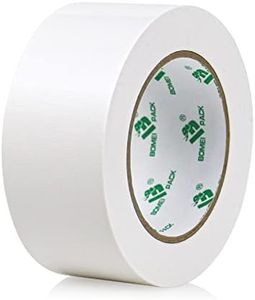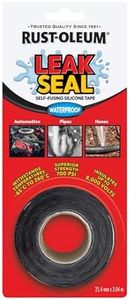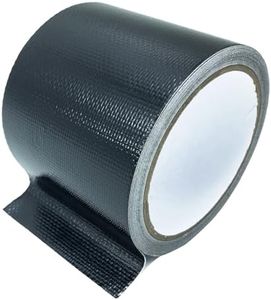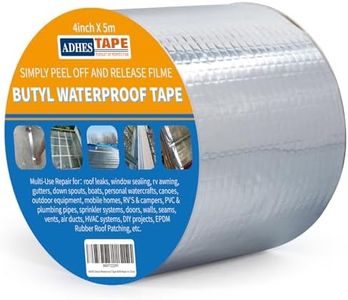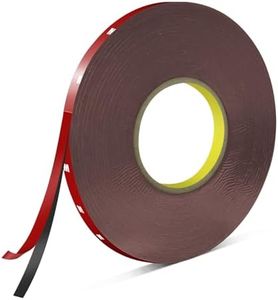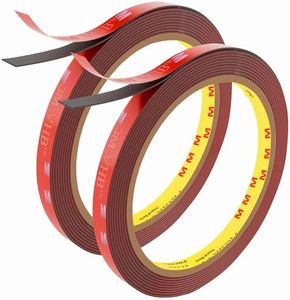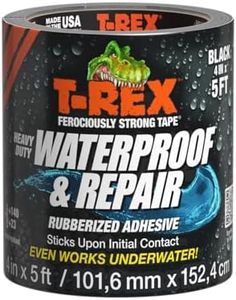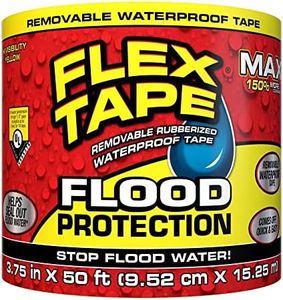We Use CookiesWe use cookies to enhance the security, performance,
functionality and for analytical and promotional activities. By continuing to browse this site you
are agreeing to our privacy policy
10 Best Waterproof Tapes
From leading brands and best sellers available on the web.Buying Guide for the Best Waterproof Tapes
When choosing a waterproof tape, it's important to focus on how and where you plan to use it. These tapes are especially useful for patching leaks, sealing joints, or protecting surfaces from moisture. To choose the best one, think about whether you need it for plumbing repairs, outdoor fixes, or general household tasks. Matching the tape’s qualities to your specific situation will help ensure you get durable and long-lasting results.Adhesion StrengthAdhesion strength describes how well the tape sticks to different surfaces. Strong adhesion is crucial if you’re dealing with wet or uneven materials or if the tape needs to hold under pressure. Adhesive strength can be ranked as light, medium, or heavy duty. Light adhesion is fine for indoor or temporary fixes, medium is good for standard repairs or moderate moisture, while heavy duty is best for outdoor jobs, plumbing, or places where water pressure is high. For your use, consider what surface you’ll be applying the tape to and how demanding the environment is, then choose a strength that matches your repair needs.
Water Resistance LevelThe water resistance level tells you how well the tape keeps water out. Some tapes are splash-proof, some can handle full submersion, and others are rated for high-pressure leaks. Splash-proof tapes work for minor drips or condensation, waterproof tapes meant for full submersion are ideal for pools or tanks, and the most robust types are designed for active leaks in plumbing systems. Think carefully about the level of water exposure in your situation and pick a tape that exceeds your likely worst-case scenario.
FlexibilityFlexibility is about how easily the tape can bend or stretch to fit around corners, odd shapes, or uneven surfaces. High flexibility is important if you need to seal pipes, curves, or joints, while more rigid tapes might be okay for flat surfaces or seams. If your repair area is complicated, opt for a more flexible tape to ensure full coverage and a tight seal.
ThicknessThe thickness of the tape affects its durability and sealing power. Thinner tapes are easier to wrap and shape, but might not last as long or hold up under heavy leaks. Thicker tapes generally offer better sealing and longer wear, especially in demanding environments. For light, indoor work, thinner tape may suffice, while thicker tape is a better choice for outdoor, high-pressure, or heavy-duty repairs.
Temperature ResistanceTemperature resistance measures how well the tape performs in hot or cold conditions. Some tapes become brittle in the cold or lose stickiness in heat. Tapes usually list their working temperature range; standard tapes manage everyday indoor temperatures, but if your project is outside or in a hot engine room or freezing basement, look for a product rated for wider or extreme temperatures. Always select a tape that’s rated above and below the temperatures you expect in your repair location.
Ease of ApplicationEase of application covers how simple it is to use the tape—whether it tears easily by hand, needs scissors, or comes with a backing layer that must be removed. Simple, user-friendly tapes are ideal for quick home repairs or situations where precision isn’t critical. But for larger, more serious fixes, a tape that requires a bit more careful application could offer a more reliable seal. Think about how often and quickly you’ll need to use the tape, as well as your comfort with the application process.


